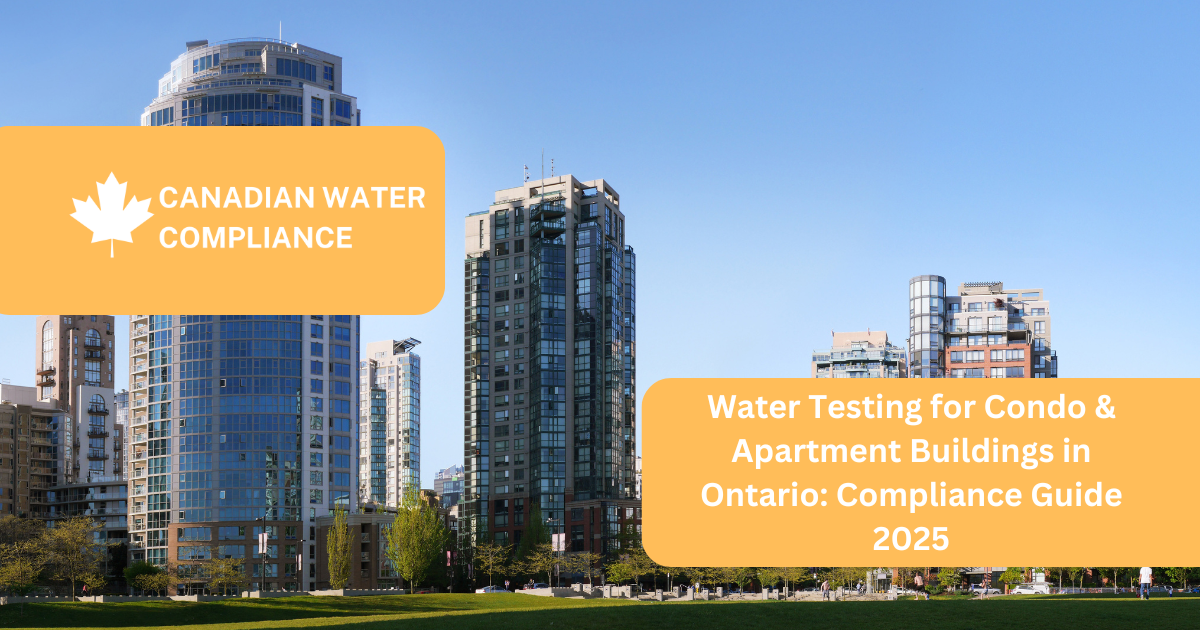
Written By: Canadian Water Compliance | On
Ensuring safe and compliant water quality in condo and apartment buildings is a critical responsibility for property managers across Ontario. Poor water quality can lead to health risks, legal issues, and compliance violations under Ontario's stringent drinking water regulations.
This guide covers:
Ontario’s water testing requirements for multi-unit residential buildings
Key contaminants to test for
Best practices for property managers to stay compliant
In Ontario, property managers, building owners, and condo boards share legal responsibility for maintaining water quality under the Safe Drinking Water Act (SDWA), 2002 (Ontario Regulation 170/03).
Buildings with their own water system (e.g., private wells, storage tanks) must adhere to SDWA testing and reporting.
Buildings connected to municipal water must still monitor in-building plumbing for risks such as lead contamination and Legionella bacteria.
Condo boards & landlords must ensure compliance with provincial health and safety laws.
Water testing in condos and apartment buildings should cover:
Older buildings with lead pipes or fixtures can experience lead leaching into drinking water. Ontario’s Lead Reduction Program requires testing in residential buildings built before 1990.
Cooling towers, water storage tanks, and complex plumbing systems in large buildings can harbor Legionella, the bacteria responsible for Legionnaires’ disease. Routine Legionella testing is required for compliance with public health safety standards (Health Protection and Promotion Act).
Coliforms, E. coli, and other bacteria can enter the water supply due to pipe corrosion, cross-connections, or contamination. Regular microbiological testing is essential.
High mineral content in water can cause pipe scaling, appliance damage, and reduced plumbing efficiency.
The recommended testing frequency varies based on the building’s water system:
Lead Testing – Every 3 years for older buildings (pre-1990) or as required by municipal bylaws.
Legionella Testing – Every 3 to 6 months for buildings with cooling towers, water storage tanks, or complex plumbing systems.
Bacteria & E. coli Testing – Annually or after plumbing work/renovations.
Water Hardness & Chemical Testing – Annually, or if residents report scaling issues.
Regulates drinking water systems and testing requirements.
Mandates lead testing for designated facilities and multi-unit buildings.
Establishes plumbing & material standards to prevent contamination.
Requires low-lead plumbing fixtures in new constructions.
Enforces Legionella control measures in buildings with cooling towers.
Public health inspectors can issue orders for non-compliance.
✅ Schedule Regular Testing – Work with a certified water testing provider like Canadian Water Compliance.
✅ Maintain Accurate Records – Keep test results for 5+ years for legal compliance.
✅ Inform Residents – Educate tenants about water quality & maintenance updates.
✅ Upgrade Plumbing Where Needed – Replace outdated lead pipes & fixtures.
Property managers play a key role in maintaining water safety in condo and apartment buildings. Regular testing for lead, Legionella, and bacteria ensures compliance with Ontario laws and protects residents from health risks.
🔎 Need professional water testing for your condo or apartment building? Contact Canadian Water Compliance today!